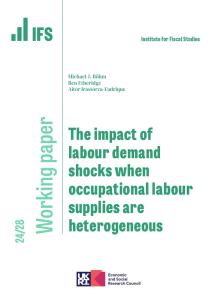The Green Budget 2008 was edited by Robert Chote, Carl Emmerson, David Miles and Jonathan Shaw, and copy-edited by Judith Payne. It was produced in collaboration with Morgan Stanley and with additional funding from the ESRC-funded Centre for the Microeconomic Analysis of Public Policy at IFS. |
Chapter 1: SUMMARY
Chapter 2: THE PUBLIC FINANCES UNDER LABOUR
2.1 Introduction: Labour's fiscal objectives
2.2 Labour's inheritance
2.3 Labour's record to date
2.4 Performance relative to the Conservatives
2.5 Labour's plans and forecasts
2.6 Uncertainty and the Treasury's fiscal forecasts
2.7 Conclusion
Chapter 3: THE FISCAL RULES AND POLICY FRAMEWORK
3.1 Introduction
3.2 The golden rule
3.3 The sustainable investment rule
3.4 Reforming the rules: a golden opportunity?
Chapter 4: THE ECONOMIC OUTLOOK
4.1 Introduction
4.2 Recent developments and near-term outlook
4.3 Trend growth and the economic cycle
4.4 The next five years: two scenarios
Chapter 5: GREEN BUDGET PUBLIC FINANCE FORECASTS
5.1 Introduction
5.2 Short-term projections
5.3 Medium-term prospects
5.4 Alternative macroeconomic assumptions
5.5 The fiscal rules and the budget judgement
Chapter 6: FUNDING, DEBT MANAGEMENT, AND CREDIT MARKET PROBLEMS
6.1 Introduction
6.2 The likely scale of debt issuance
6.3 Government debt and the money market crisis
6.4 Optimal debt management
6.5 Government policy and the 'credit crunch'
6.6 Mortgages and mortgage financing - the role of indexation
6.7 Conclusion
Chapter 7: PRESSURES ON PUBLIC SPENDING
7.1 Introduction
7.2 Trends in aggregate public spending under Labour
7.3 Trends in key areas of public spending
7.4 Conclusion
Chapter 8: PUBLIC SECTOR PAY AND PENSIONS
8.1 Introduction
8.2 The public sector pay bill and workforce
8.3 Public sector pay trends and levels
8.4 Public sector pensions
8.5 Public sector pay policy and inflation
8.6 Pay review bodies
8.7 Conclusion
Chapter 9: AVIATION TAXES
9.1 Introduction
9.2 Economic principles of aviation taxation
9.3 Air passenger duty
9.4 Aviation duty: illustrative options for reform
9.5 Issues in aviation tax reform
9.6 Conclusion
Chapter 10: CAPITAL GAINS TAX
10.1 Introduction
10.2 Background
10.3 CGT design and the proposed reform
10.4 Managing transition
10.5 The policymaking process
10.6 Conclusion
10.7 Postscript: entrepreneurs' relief
Chapter 11: CORPORATION TAX AND ENTREPRENEURSHIP
11.1 Introduction
11.2 Corporation tax rates and entrepreneurship
11.3 Conclusion
Chapter 12: TAXATION OF COMPANIES' FOREIGN PROFITS
12.1 Introduction
12.2 The current UK system
12.3 Principles guiding the taxation of foreign profits
12.4 The June 2007 proposals
12.5 Implications of the proposed exemption system
12.6 Conclusion
Chapter 13: TAX SIMPLIFICATION
13.1 Introduction
13.2 A 10-yearly simplification cycle?
13.3 Recent 'simplifications' in practice
13.4 Conclusion
Chapter 14: THE IMPACT OF TAX AND BENEFIT REFORMS TO BE IMPLEMENTED IN APRIL 2008
14.1 Introduction
14.2 The changes due in April 2008
14.3 The impact on effective marginal tax rates
14.4 Winners and losers
14.5 The impact of tax and benefit changes since 1997
14.6 Conclusion
APPENDICES
Appendix A: Forecasting public finances
Appendix B: Headline tax and benefit rates and thresholds
© The Institute for Fiscal Studies, January 2008












